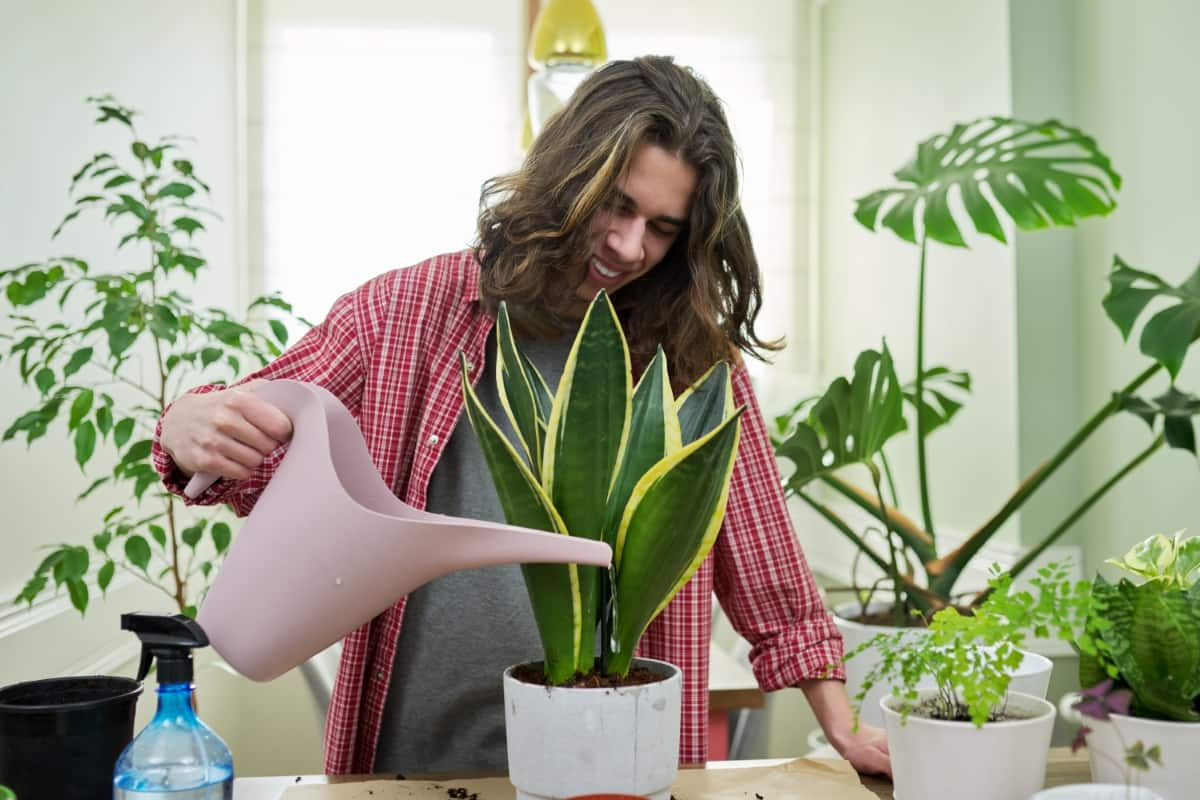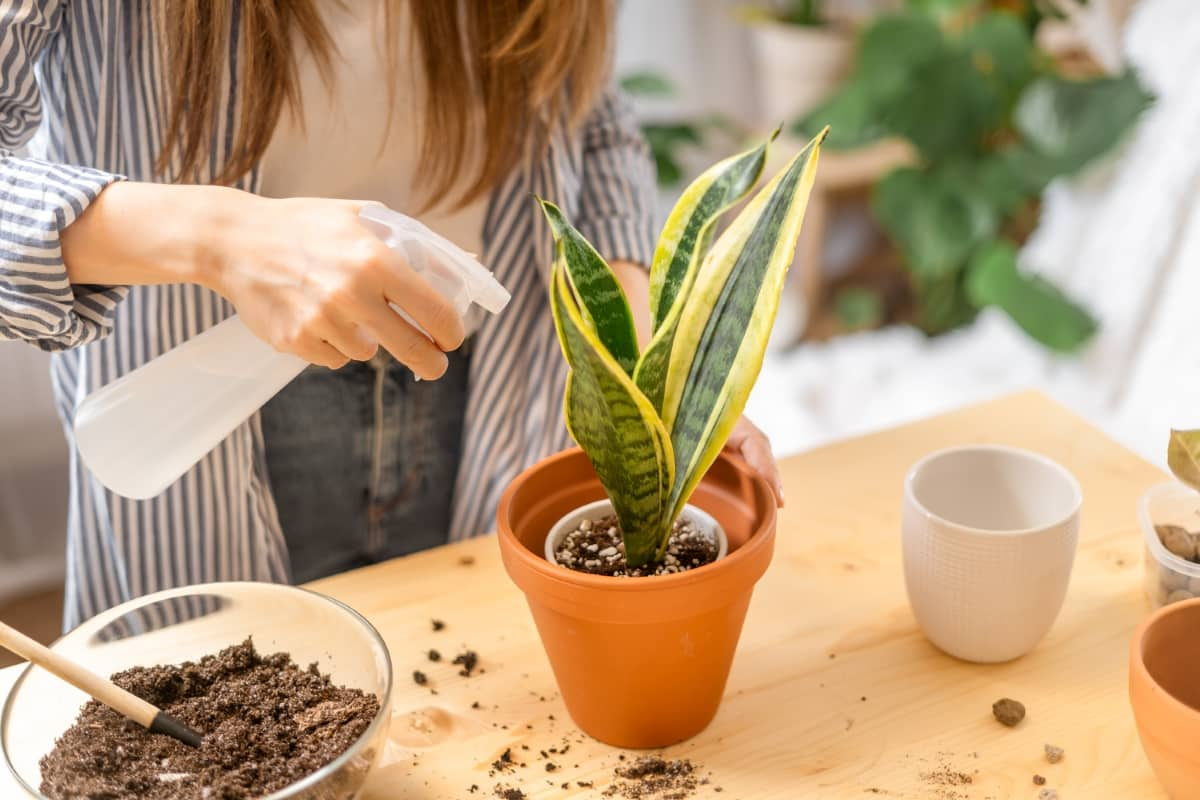Snake plants, scientifically known as Dracaena trifasciata, are beautiful additions to indoor or outdoor spaces, and they also offer a range of benefits that make them worth growing. These resilient plants have gained popularity in recent years, and for good reason. The main benefit of growing Snake plants is their ability to purify the air.

How Often Should You Water Snake Plants
Snake Plant Watering Schedule Guide
The frequency of watering Snake plants depends on several factors, including the temperature, humidity levels, and the type of potting mix used. Generally, it is recommended to allow the soil to dry out completely between waterings. For most indoor environments with average humidity levels, watering once every two to three weeks is sufficient.
However, during warmer months or if your home has low humidity, you may need to increase the frequency slightly. When it comes to outdoor Snake plants in gardens or containers, they generally require less frequent watering due to natural rainfall. It’s important not to overwater the Snake plant, as this can lead to root rot.
Snake Plant Watering Schedule
| Snake Plant Size | Watering Frequency Schedule |
| Small Snake Plants (up to 12 inches) | Every 2-3 weeks |
| Medium Snake Plants (12-24 inches) | Every 3-4 weeks |
| Large Snake Plants (24+ inches) | Every 4-6 weeks |
Watering Frequency for Snake Plants
Determining the right watering frequency is crucial for the plant’s health and well-being. Snake plants prefer to be slightly underwatered rather than overwatered. During colder months or dormancy periods, which typically occur in fall and winter, watering frequency is reduced significantly.
Snake plants require less moisture during these times as they enter a period of rest. When watering your Snake plant, ensure that you drench the soil until water drains out from the bottom of its pot. This will prevent any potential salt buildup or nutrient deficiencies that may arise from inadequate flushing.
Indoor vs. Outdoor Snake Plant Watering
Indoor Snake plants tend to have a controlled environment with stable temperature and humidity levels. The soil in indoor pots tends to dry out more slowly, so you won’t need to water them as often. Outdoor Snake plants, on the other hand, are exposed to fluctuating weather conditions. They may experience higher temperatures and stronger sunlight than indoor plants. These factors can cause the soil to dry out more quickly during hot summer months.
In case you missed it: The Benefits of Having Snake Plants in the Home

Signs of Overwatering and Underwatering
Overwatering the plant is a common issue, and it can lead to root rot. Signs of overwatering Snake plants include yellow or wilting leaves, mushy roots, and a foul smell coming from the soil. If you notice these symptoms, it’s important to allow the soil to dry out before plant watering. On the other hand, underwater Snake plants may have wrinkled or drooping leaves that appear dry and brittle.
The soil will also feel dry to the touch. To remedy this, increase your watering frequency, but be careful not to go overboard. It’s worth noting that certain factors like temperature, humidity levels, pot size, and even the type of potting mix used can affect how often you need to water your Snake plant. Pay attention to these variables as you assess your plant’s hydration needs.
Soil and Pot Selection Impacts Watering Needs
The type of soil you choose can impact how well it retains moisture, while the size and material of the pot can affect drainage. Choose a well-draining mix specifically formulated for succulents or cacti. In terms of pots, choose ones with drainage holes at the bottom. This allows excess water to escape instead of pooling at the bottom of the pot. Additionally, consider using terracotta pots, as they allow for better airflow to the roots.
Seasonal Watering Adjustments
Understanding these seasonal adjustments is crucial for maintaining their health and vitality throughout the year. During the spring and summer, Snake plants tend to grow more actively. This increased growth means they will require slightly more water than during the cooler months. However, it’s important not to overwater them. Instead, adjust your watering frequency by monitoring the moisture levels in the soil.
In contrast, during fall and winter, when Snake plants enter a period of dormancy, their watering requirements decrease significantly. The reduced sunlight and cooler temperatures slow down their growth rate, resulting in less water loss through transpiration. During this time, you should cut back on watering frequency to prevent root rot.
Fertilization and Watering
A general rule of thumb is to fertilize your Snake plant once every two months during the growing season (spring and summer). It’s important not to forget that proper watering goes hand in hand with fertilization. Before applying any fertilizer, make sure that the soil is adequately moist but not soggy. This will help prevent root damage and ensure effective nutrient uptake by the plant.
Propagation and Watering
To propagate a Snake plant through leaf cuttings, you’ll need to provide adequate moisture without overdoing it. One common approach is to place the leaf cutting in water until roots develop, which usually takes about two weeks. During this time, make sure to change the water every few days to prevent stagnation and promote healthy growth. Once roots have formed, you can transfer the cutting into the soil.
It’s important to maintain consistent moisture levels during this initial stage of growth. Too much water in the Snake plant can lead to root rot, while too little can hinder root development. As with established Snake plants, it’s essential not to overwater newly propagated ones. By properly watering your propagated Snake plants, you’ll give them the best chance at thriving and maturing into beautiful additions to your indoor or outdoor space.
Dormancy Periods and Watering
During these periods, the growth of the plant slows down, and its water requirements change. During dormancy, which typically occurs in winter or colder months, Snake plants enter a period of rest. To determine when your Snake plant is entering dormancy, keep an eye out for signs such as slower growth, yellowing leaves, or a general lack of vigor. Once you notice these signs, it’s time to adjust your watering frequency accordingly. During dormancy periods, reduce the frequency of watering significantly. This will help prevent overwatering and promote healthy root development.
In case you missed it: The Best Soil Mix for Snake Plants: A Comprehensive Guide

Light and Watering
Snake plants are known to thrive in low-light conditions. In lower-light situations, the soil takes longer to dry out, so you won’t need to water as frequently. On the other hand, if your Snake plant is placed in a bright spot with direct sunlight, the soil will dry out faster, and you may need to increase your watering frequency. Finding the right balance between light exposure and proper watering is key when caring for Snake plants.
Troubleshooting Common Watering Issues
Using improper potting soil or selecting an incorrect pot size can also impact watering needs. Snake plants prefer well-draining soil, so using a mix specifically designed for succulents or cacti is recommended. Additionally, choose a pot with drainage holes to prevent excess moisture from accumulating in the roots.
Another issue that may arise is improper drainage. Ensure that your containers or pots have drainage holes, and use a well-balanced potting mix specifically designed for succulents. Inconsistent watering routines can confuse and stress out your Snake plant. Establishing a consistent schedule will provide stability and promote healthy growth.
In case you missed it: Snake Plants in the Office: Boosting Productivity and Reducing Stress

Conclusion
Growing Snake plants can bring numerous benefits to your living space. These hardy and low-maintenance plants not only add a touch of greenery but also help improve indoor air quality. The significance of growing Snake plants lies in their capacity to purify the air by releasing oxygen.
- Feed Your Flock for Less: Top 10 Tips to Save on Chicken Feed
- Ultimate Guide to Ossabaw Island Hog: Breeding, Raising, Diet, and Care
- Hatching Answers: The Top 10 Reasons Your Chickens Aren’t Laying Eggs
- Eggs and Economics: Breaking Down the Cost of Raising Backyard Chickens
- Defend Your Greens: Proven Methods to Keep Iguanas Out of Your Garden
- Ultimate Guide to Cinnamon Queen Chicken: A Comprehensive Guide for Beginners
- Ultimate Guide to California Tan Chicken: Breeding, Raising, Diet, Egg-Production and Care
- Ultimate Guide to Marsh Daisy Chicken: Breeding, Raising, Diet, and Care
- 10 Types of Chicken Farming Businesses You Can Start for Profits